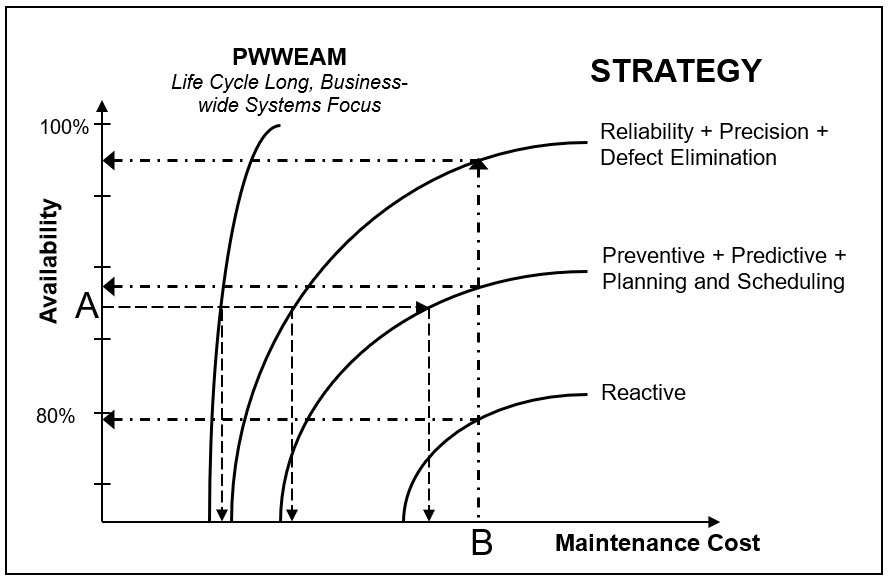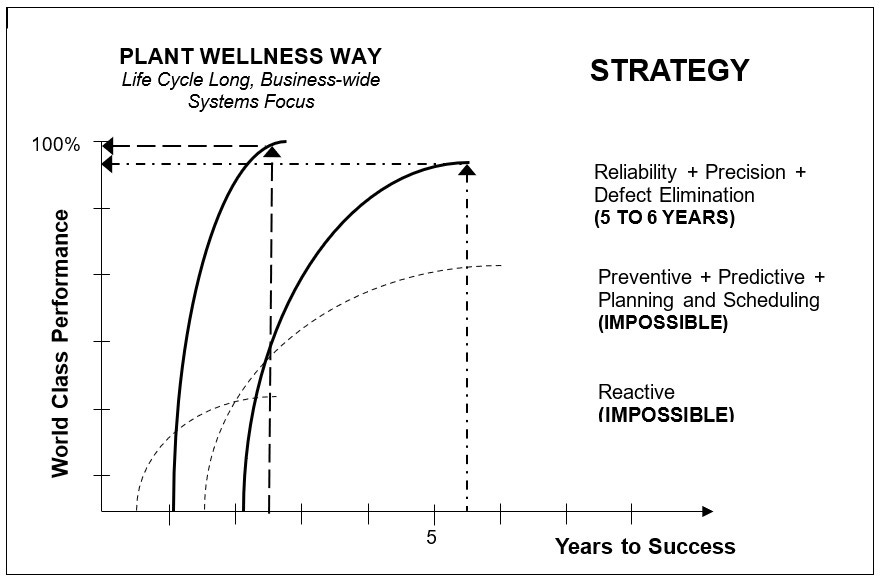Building Failure-Free EAM Systems and Processes
Plant & equipment reliability problems and failures stop once your EAM systems & processes implement the strategies that ensure outstandingly reliable equipment.
The famous quality system guru, W. Edwards Deming, wrote that 94% of an organization’s problems, i.e. 19 in 20 problems, were caused by the organization’s systems and processes, and 6% by people. His advice was to focus on reengineering and rebuilding your systems to remove the causes of the problems and not to go around blaming people—that won’t fix the 94% of failures attributable to the system and processes.
The figure below has the right answer to getting outstandingly reliable plant and equipment. Represented, are research findings from DuPont on various strategies tested in continuous process plant operations with the resulting availability, or uptime, they delivered. There was only one set of maintenance and reliability strategies that guaranteed exceptional plant and equipment uptime.
The challenge faced by organizations today is not discovering the right strategies for exceptional uptime, they are already known. Today’s challenges are how to quickly and successfully imbed those best strategies into their organizational systems and processes and ensure everyone does them properly.
Point A, near to 90% availability, can never be reached in reactive operations. These unfortunate businesses are doomed to always have costly maintenance and poor production performance for as long as they are a reactive operation.
A combined strategy of preventive, predictive, and planned maintenance might achieve around 90% availability. These businesses will get better production performance and lower maintenance costs because their maintenance efforts are well coordinated with production needs.
It is only when you combine reliability growth, precision maintenance, and defect elimination strategies that you can get outstanding operational asset uptime.
Point B shows that availability has little to do with how much money you spend on maintenance. For identical maintenance costs, the strategy selected has the greatest impact on production and maintenance performance.
The figure above highlights that world class operational performance is only possible to reach by implementing a specific set of strategies.
Using PWWEAM delivers world class operating asset performance much faster than if you don’t use it because it gets you using reliability growth, precision maintenance, and defect elimination strategies faster than any other way.
Its holistic, life cycle long, and business-wide “system of reliability” methodology quickly produces highly reliable plant and machinery because it short-cuts the time needed to incorporate the best strategies throughout an organization’s systems and successfully implement them in the workplace. Its proactive identification and removal of operational risks from throughout the life cycle quickly brings high equipment reliability, plant availability, asset utilization, and least production unit cost.
The decision to use PWWEAM as a company’s operating asset management and reliability growth methodology gives you the means to create the right systems and processes with the EAM, maintenance, and reliability strategies and practices that enable lasting world class operational success.
Put the success you want into your systems and processes
The last seven PWWEAM Substack newsletters were about designing and building a maintenance planning and resourcing process that ensured top-class, right-first-time maintenance work packs from the Planners. It needed seven newsletters to gradually introduce the PWWEAM system and process creation methodology and its use to readers.
The maintenance job planning process was selected as the example use of PWWEAM because maintenance planning is a process that few organizations do well. When maintenance planning is done badly, and too often planning is not done at all, vital maintenance job preparation is not done and so key job tasks are wrongly done and equipment fails again, and again.
The PWWEAM Systems & Processes methodology was developed to change the systems and processes in organizations with poor plant and equipment reliability to systems and processes that cause outstanding reliability.
The PWWEAM methodology 7-step approach is universal and it can be used on all systems and processes. The 7-steps, summarized below, with links to their PWWEAM Systems & Processes Substack explanations, gives you a standardized way to improve any system or process.
Describe the outcomes required from a system’s process and specify the individual steps to do to produce those outcomes. Layout all process steps in a spreadsheet and under each step describe the key procedural tasks to do to properly complete the step.
Write the full first draft procedure explaining each step’s tasks and include all the individual activities needed to complete each task.
Flowchart the process and procedure to show interactions along the process and with any external processes. Develop a deployment chart showing role responsibilities to do the work required in the process. Update the process and procedure as better understanding is gained in making the process effective and efficient.
Create a Chance of Success Map of the process in a spreadsheet and for each task in a step gauge the highest chance of its successful completion and its lowest chance of being successfully done. Identify all the risks that can arise in the step tasks to cause low chances of success.
https://pwweam.substack.com/p/step-4-chance-of-success-mapping-your-processes-and-procedures
Review and select ways to lift each step’s low chance of success by eliminating or preventing every risk to the successful completion of the step. Confirm the potential increase in the whole process’ chance of success in a Chance of Success Map.
https://pwweam.substack.com/p/step-5-access-how-maintenance-planners-make-most-successful-work-packs
Install the selected risk eliminations and risk controls into the relevant processes and procedures, including in all external processes impacting the outcomes.
https://pwweam.substack.com/p/step-6-save-your-planners-from-risk-of-failure-with-foresight
Challenge your process steps to optimize them for more productivity, more profitability, more workplace successes. When your process can’t be saved, replace it with one designed and built to dazzlingly succeed.
https://pwweam.substack.com/p/step-7-optimize-processes-by-removing-uncertainty-and-risk
Trial the methodology on a problem work process
It’s by using the 7-step methodology that you’ll know whether its promise of great system and process success will be true for you. Pick a problematic process at your workplace and put PWWEAM to the test. Give yourself 3 - 4 months to trial it.
If your problem process and procedures are already documented, then go straight to PWWEAM Step 3 and flowchart the process steps with their key procedural tasks in a spreadsheet.
If your problem process is undocumented, then start at PWWEAM Step 1 and write each process step and its key tasks in the order they are done. Turn the process steps and their tasks into a full first-draft procedure as noted in PWWEAM Step 2. Flowchart the draft process steps and key procedural tasks in the spreadsheet required by PWWEAM Step 3.
Keep working your way through the methodology a step at a time. Refer back to the relevant step newsletter to help you with each PWWEAM step. If you are a PWWEAM Substack subscriber, you can contact me directly for assistance.
The Industrial and Manufacturing Wellness Book is helpful
There’s detailed information on building highly successful industrial and operational processes and procedures with the PWWEAM methodology in the Industrial and Manufacturing Wellness book from publisher, Industrial Press.
Help people in your organization to build great systems and processes by telling about becoming a PWWEAM Systems & Processes Substack subscriber. Every post and newsletter has insights into creating highly successful organizational systems, processes, procedures, and operating assets with the PWWEAM methodology.
Contact me if you have any questions on the above information.



